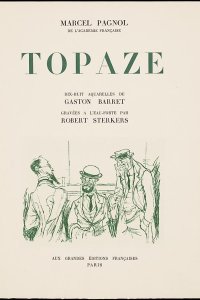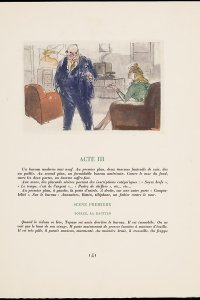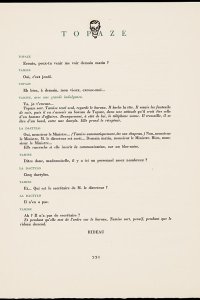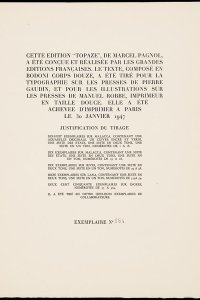Topaze
- Year:
- 1947
- Author:
- Marcel Pagnol (1895 - 1974)
- Artist:
- Gaston Barret (1910 - 1991)
- Publisher:
- Aux Grandes éditions françaises
Meekness versus harsh reality
Pagnol initially worked as a teacher at various secondary schools in the south of France. As an English graduate he was able to secure a position in 1922 at the Lycée Concorcet in Paris. The city was then still suffering the consequences of World War I. The economy was recovering very slowly, mutilated war victims were begging in the streets, large-scale flight of capital and financial scandals were reported daily. Pagnol's early work often dealt with the meek straightness of well-intentioned teachers opposite the harshness of everyday reality. Themes such as self-interest and indecency recurred throughout his work.
Before Topaze, Pagnol had written some successful plays in which he offered satirical social commentary on his own age. Predecessors of his, like Octave Mirbeau and especially Henri Becque, bitter critics of the nineteenth-century bourgeoisie, were an important source of inspiration. Although Pagnol's first plays are modern and cynical (truth and virtue offer no advantage at all in a world full of rottenness and lies), the influence of the avant-garde is nowhere to be seen in it. Pagnol, although well versed in the avant-garde repertoire of his time, chose for easy, pleasantly written plays, recognizable for a large audience; 'la pièce bien faite'. The plays, with their hilarious machinations, amusing characters and lively dialogues, lent themselves well to film adaptation. Topaze especially was filmed many times, including two versions (in 1936 and 1950) directed by Pagnol himself. A Hollywood version was made in 1933 starring John Barrymore and Myrna Loy, while Topaze also managed to conquer the silver screen in England (with Peter Sellers), Egypt and even China.
Humourous visualisations
Topaze was published yet again in 1947 by the Grandes Éditions Françaises. Only 300 copies were printed, each of which featured eighteen coloured aquarelles by Gaston Barret, created by Robert Sterkens with the etching technique. They offer humorous visualisations of the environment of the strict, decent schoolmaster and that of the voluptuous Suzy and her evil, avaricious lover Castel Bérac. Besides Topaze, Barret also illustrated Marius (1929), which was also written by Pagnol. Little is known about Gaston Barret. In the first half of the twentieth century, he illustrated the work of Jean de la Fontaine, Gustave Flaubert, Maurice Genevoix and Anoine de Saint-Exupéry, and others. He also created a number of erotic prints in 1951 for Justine ou les maleurs de la vertu by Marquis de Sade. Topaze is much less daring, but wherever love enters the picture, the occasional sensual image can also be found.
Bibliographical description
- Description:
- Topaze / Marcel Pagnol ; 18 aquarelles de Gaston Barret, grav. à l'eau-forte par Robert Sterkers. - Paris : Aux Grandes éditions françaises, 1947. - [221] p. : ill. ; 33 cm
- 1st edition:
- 1930
- Printer:
- Pierre Gaudin (Parijs) (text); Manuel Robbe (Paris) (illustrations)
- Edition:
- 304 copies
- This copy:
- Number 186 of 250 on Ingres
- Type:
- Bodoni
- Shelfmark:
- Koopm A 325
References
- David Coward, 'Introduction', in: Marcel Pagnol, Topaze: pièce en quatre actes. London, Harrap, 1981
- Jacques Bens, Pagnol. Paris, Seuil, 1994


![Pagina [9] met illustratie door Gaston Perret](/sites/default/files/styles/galerie/public/images/topaze-p9.jpg?h=823c10a2&itok=lZ8RMeZK)

![Pagina [183] met illustratie door Gaston Perret](/sites/default/files/styles/galerie/public/images/topaze-p183.jpg?h=825eb4f8&itok=RCHoYQY2)

